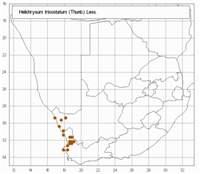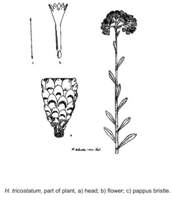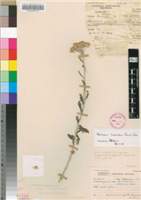Common names:
Henningbos (A)
Origin of name:
tricostatum = having three primary veins or ridges
Diagnostic characters:
Medium sized flowersStraw-coloured bractsDense inflorescences
Description:
Shrub or subshrub up to 1.5 m tall, branches long, slender, young parts thinly white-woolly, leafy. Leaves mostly 15-30 x 5-8 mm, reduced and more distant upwards, oblanceolate to narrowly elliptic, linear-lanceolate upwards, apex acute, mucronate, base narrowed, minutely petiolate, margins subrevolute, both surfaces thinly greyish-white woolly. Heads homogamous, campanulate, c. 4 x 3 mm, woolly at base, many in terminal compact corymbose panicles. Involucral bracts in 5 series, imbricate, graded, inner about equaling flowers, oblong, translucent, tips rounded, subopaque, convex, glossy, straw-coloured, not radiating. Receptacle with fimbrils equaling or exceeding ovaries. Flowers 18-26. Achenes 1 mm long, cylindric, obscurely angled, glabrous. Pappus bristles many, about equaling corolla, scabrid, barbellate above, bases cohering lightly by patent cilia.
Flowers between September and December.
Distribution:
Endemic to the Sandveld of Namaqualand and the Western Cape from Hondeklipbaai south to Buck Bay, N. of Cape Town.
Fynbos and Succulent Karoo Biomes.
Notes:
Closely resembles H. hebelepis in foliage but easily recognized by its different involucre, fimbrilliferous receptacle and glabrous ovaries.
Recorded as much eaten by stock.
Taxonomy:
Literature:
Helichrysum tricostatum (Thunb.) Less., Syn. Comp. 310 (1832); DC., Prodr. 6: 209 (1838); Harv. in F.C. 3: 251 (1865); Moeser in Bot. Jb. 44: 290 (1910).
Type:
Cape, Piketberg, Thunberg (sheet 19277, UPS, holo.).
Synonym(s):
Gnaphalium tricostatum Thunb., Prodr. 151 (1800), Fl. Cap. 657 (1823), non DC. (1838).
Vouchers:
Acocks 14816 (PRE); Compton 18906 (NBG); Taylor 5506 (K; PRE); Nordenstam 3413 (NU; S); Pillans 5129 (BOL; K).


